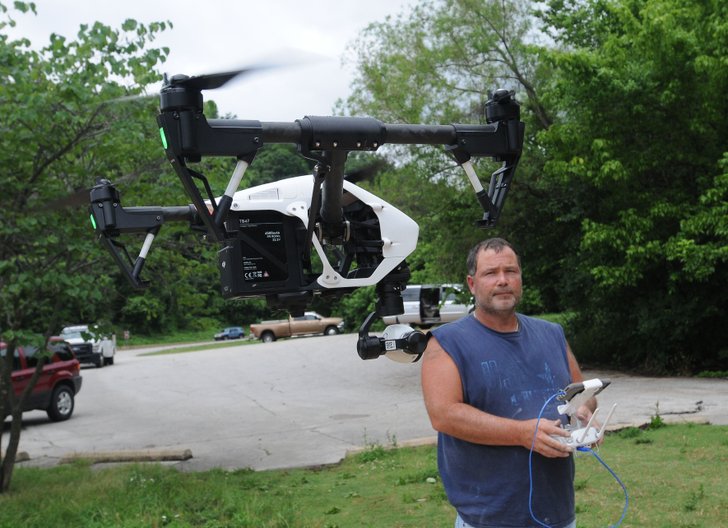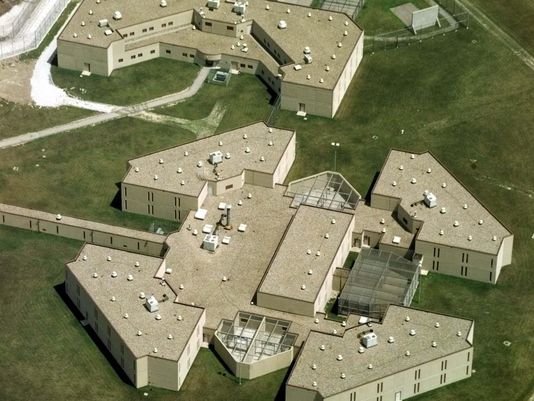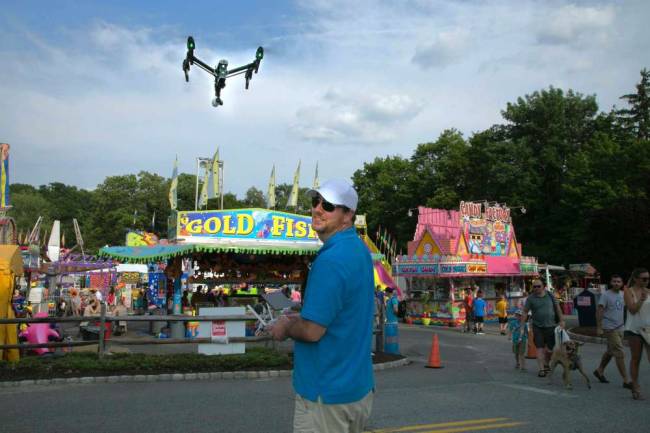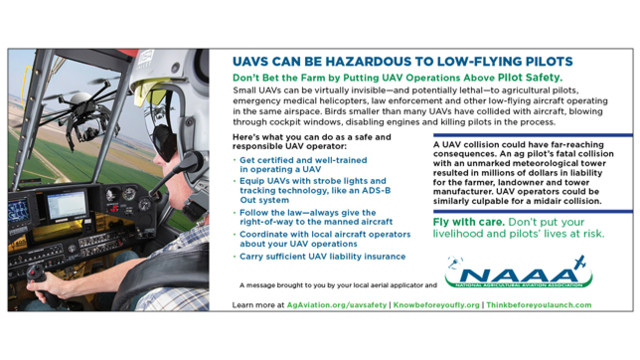
By Doug Thompson
No aircraft has hit a drone in Arkansas or anywhere else in the United States, Federal Aviation Administration records show. Airport managers, regulators, pilots, aircraft passengers and private drone operators want to keep that record.
“Hitting a bird can bring down an airplane,” said James Smith, manager of the Springdale Municipal Airport. “Imagine what a drone can do.” FAA rules allow a maximum weight of 55 pounds for private drones, which use electric motors powered by batteries.
Sales of drones for private used by hobbyists are not tracked by the FAA. The U.S. Consumer Electronics Association projects sales of 700,000 remotely piloted aircraft this year, ranging from small remote control planes to large “Unmanned Aircraft Systems” capable of carrying a large, professional-grade camera. Worldwide sales of the larger craft are expected to be 80,000 units this year, according to industry accounts.
The FAA expects to approve its 1,000th request for private, commercial use of drones sometime this week, said Les Dorr, agency spokesman. Any drone used for a commercial purpose requires both an exemption from the noncommercial restriction by the FAA and operation by someone who holds a regular pilot’s license, just like that required to fly an aircraft.
Those requirements would change under a set of rules proposed by the FAA in February, said both Dorr and Tom McMahon, spokesman for the Association for Unmanned Vehicle Systems International, an industry group. The new set of rules would set up a certification process just for drone operators.
Parties interested in commercial drones range from photographers to real estate companies, news organizations and farmers wanting to monitor crops. Many existing restrictions on drones would still apply, such as operation being limited to daylight hours and only as long as the operator keeps the drone within his direct line of sight.
Drones can be hard to see even when ground clutter below them isn’t a factor for a pilot in a descending airplane, and they are too small to be tracked by airport radar, Smith said. Drone owners in Northwest Arkansas have been very responsible, though, Smith said.
“I’ve received a grand total of one telephone call about a drone, and it was the mother of someone who lost his and, as far as we can tell, it was never near the airport,” he said.
The overwhelming majority of drone operators around the country have also been responsible and cooperative with the FAA in helping refine a set of proposed rules, Dorr said. Those proposals drew more than 4,500 comments during the process of drafting them, he said.
“U.S. airspace is the most complex and crowded in the world, but we’ve met challenges before,” Dorr said. “The FAA is in the business of getting new technology into the nation’s airspace safely.”
The proposed regulations are practical and workable, said Jimmy Harmon of Bella Vista, owner of a polished concrete company who is also a photographer and drone owner.
Both existing rules and the proposed FAA regulations make it illegal to fly them above 500 feet, the minimum safe altitude for manned aircraft. They are forbidden to fly within five miles of a major airport or leave the line of sight of the operator. They would only be allowed to operate in daylight hours.
The FAA has the authority to punish drone operators for unsafe operation under the same laws restricting flights by pilots of regular aircraft, courts have ruled. For example, someone who flies an aircraft over large public gatherings or places where any flights are restricted, such as over some national parks, public buildings or defense installations, could face fines and up to a year in prison.
An unmanned drone beer delivery service for ice fishermen in Minnesota was shut down by the FAA last year when told the practice violated the “noncommercial” drone restriction.
State laws can also apply. Arkansas has anti-voyeurism laws that prohibit invasions of privacy and which apply to those using drone cameras under amendments to that law made in the last legislative session.
Out-of-state, two people were arrested in July 2014 on “reckless endangerment” charges when a New York Police Department helicopter had to swerve to avoid their drone, according to news accounts. Six months before, New York police arrested a Brooklyn man for the same charge after he lost control of his remote control helicopter. The craft crashed, falling so far that authorities believed it substantially risked the safety of others.
Not all the legal risks involving drones are faced by owners and operators. William H. Merideth, 47, of Hillview, Ky., shot down a drone flying over his house recently. He was charged with first-degree criminal mischief and first-degree wanton endangerment for discharging a firearm within city limits and destroying the $1,800 drone.
“They’re going to be like guns,” Harmon said of remotely piloted aircraft. “Most people with guns are responsible. Some are not.”
In May, an airliner approaching LaGuardia Airport in New York reported passing near a drone at an altitude of 2,700 feet. It was the third report of a drone near the airport that month. Even small drones can attain altitudes of 2,000 feet if restrictions are ignored, according to industry figures.
Other countries farther along in the commercial drone approval process have had near misses. A passenger liner coming in for a landing at London’s Heathrow Airport missed a drone in July 2014. Safety authorities in Britain ruled there had been a serious risk of collision after confirming witness accounts. Crew on the aircraft said their Airbus A320 passed within 20 feet of the drone, whose owner was never identified.
This year, a Lufthansa airliner crew flying from Munich to Warsaw on July 20 reported spotting a drone as the plane came in for a landing at its destination, passing within 100 meters or 330 feet on the approach.
Irresponsible drone operators do what they do to get pictures no one else can get if they follow the rules, Harmon said. Yet the irresponsible operators don’t get “bragging rights” unless they show the pictures somewhere — in effect, providing photographic evidence that they broke the rules.
“When we see a picture somebody posts on the Internet, we can tell when it was taken from higher than 500 feet,” he said.
“I’m on a Facebook page with a lot of other drone owners,” Harmon said. “We know some members of our group work for the FAA. We’re not stupid. We know they’re there, but don’t know exactly which ones they are because we don’t ask. But when somebody posts a picture, you can bet someone will respond with something like ‘Hey, that’s not right and here’s why.’ If he gets really detailed and cites a lot of rules, you can bet he’s with the FAA. ”
Even more effectively, Harmon said, FAA regulations can be written into the computer software that controls drones, Harmon said. Updates and patches to that software could add it, he said. Harmon bought a drone with computer software in it that will land the craft automatically if it flies within five miles of an airport, he said.
The landing would come after warnings to the operator he is approaching the airport. Not all models have that feature, but they could, he said.
“Sure, you can hack the software and get around it, but the average Joe can’t,” Harmon said. “You’d really have to know what you’re doing and be pretty good at it.”
A former volunteer firefighter for the Pea Ridge Fire Department, Harmon voluntarily piloted his drone in a search for two concert-goers in Oklahoma who went missing in a flood, he said. Their bodies were later found by others outside of the area Harmon was searching. Harmon used a camera attached to a drone to conduct thorough inspections of hard-to-reach places and to cover wide areas by flying a pattern over them.
“The advantage of a drone is that you can stay over an area, fly close to the ground and really examine a place closely,” he said. “We had people looking at the images from the drone flight on Facebook. If they thought they saw something, we’d go back and look at that spot.”
As for business potential, Harmon sees it as a sideline that will offer options to his existing photography business in the future.
“People hire me for the pictures I take with the camera in my hand, not for what I can do with a drone,” he said. “Real estate is going to be really big, though. People will be able to provide pictures that show the whole property from above.”
http://www.arkansasonline.com/news/2015/aug/03/drone-safety-record-good-so-far-2015080/?latest









